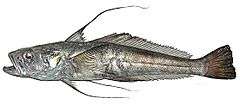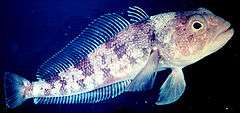Nototheniidae
| Cod icefishes | |
|---|---|
 | |
| Head of Antarctic toothfish (Dissostichus mawsoni) in McMurdo Sound | |
| Scientific classification | |
| Kingdom: | Animalia |
| Phylum: | Chordata |
| Superclass: | Osteichthyes |
| Class: | Actinopterygii |
| Subclass: | Neopterygii |
| Infraclass: | Teleostei |
| Superorder: | Acanthopterygii |
| Order: | Perciformes |
| Suborder: | Notothenioidei |
| Family: | Nototheniidae Günther, 1861 |
| Genera[1] | |
The cod icefishes or nothothens are the family Nototheniidae of acanthopterygian fishes. They are traditionally placed in the perciform assemblage together with their relatives, but like every lineage in the "Perciformes", their actual relationships are not yet determined with certainty.
They are largely found in the Southern Ocean and off the coast of Antarctica. As the dominant Antarctic fish taxa, they occupy both sea-bottom and water-column ecological niches. Although lacking a gas bladder, they have undergone a depth-related diversification, such as increased fatty tissues and reduced mineralization of the bones, resulting in a body density approaching neutral, to fill a variety of niches. The spleen may be used to remove ice crystals from circulating blood. As the chilly subantarctic waters averages –1 to 4°C, most Antarctic species have antifreeze glycoproteins in their blood and other body fluids.
Some species exhibit polymorphism, for example, the circum-Antarctic Trematomus newnesi exists as two morphs in the Ross Sea, the typical morph and a large-mouthed/broad-headed morph.
As the major fish resource in the Southern Ocean, notothens are under increasing pressure from commercial fishing.


References
| Wikimedia Commons has media related to Nototheniidae. |
- ↑ Froese, Rainer, and Daniel Pauly, eds. (2014). "Nototheniidae" in FishBase. February 2014 version.